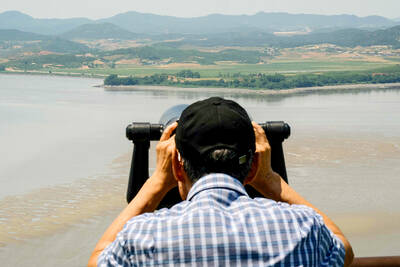The year is 2021. A frightened, angry crowd lines up outside a medical center, desperate for a cure for a terrible virus. “He pushed in front!” someone shouts.
Talk about timing. When he began making Little Fish, an intimate and affecting romance in a sci-fi setting, director Chad Hartigan had no idea the world would be coping with a real pandemic in the real 2021. Watching this fictional society begin to fray in panic feels just a tad too close for comfort.
Perhaps it’s for the best, then, that Little Fish, starring the very appealing duo of Olivia Cooke and Jack O’Connell, is a sci-fi romance that doesn’t spend too much time on the “sci.”

Photo: AP
Yes, this virus — NIA, or Neuroinflammatory Affliction — terrifyingly causes its victims to lose their memories, sometimes suddenly and sometimes slowly, with no relation to age, gender or anything else. But the focus here is on the role that memory plays in a relationship. Obviously, the memories we create together are crucial building blocks. But if they disappear, does the love remain? And what does that look like? Without a past, can we have a present, not to mention a future?
We begin on a windswept beach in the Seattle area. A young woman, Emma, sits alone, crying. A friendly dog runs up for a cuddle, soon followed by its owner, Jude. He’s surprised by her charming northern England accent. They smile.
The clever script by Mattson Tomlin flips around in time over the couple’s yearlong relationship, from first cute kiss — on line for the bathroom in a club — to moving in together, to cute proposal in a pet store, to marriage. While the approach is not linear, it doesn’t feel confusing, either, although it might be if you really tried to chronologize everything.
There’s no question we’re rooting for both of these charismatic characters. Emma, a veterinary technician, aims for a better future as a scientist. Jude is a photographer who’s been chronicling the touring rock band led by his friend, Ben. When he texts Emma soon after they meet, she’s at a Halloween party. He invites her to his party instead. She looks like George Washington, but says she’s dressed as 18th-century French veterinarian Claude Bourgelat. By the time she gets upstairs, he knows exactly who that is. “What’s your costume, guy who Googles things and pretends he already knows them?” she cracks, sweetly.
Soon they’re a couple, building memories together like that time they painted their walls yellow — Emma’s favorite color — and had a rambunctious paint fight. But remember — these memories come to us just as they’re getting lost. And so we wonder: Whose memories are we seeing, anyway? His, hers, or no one’s?
The first scary reports seem far away from everyday life. There’s a fisherman who forgot how to operate his boat, so he jumped into the water to swim home. People suddenly forget how to drive cars. Most seriously, pilots lose the ability to fly, midair.
Then the virus hits Ben (Raul Castillo). His girlfriend Sam (the singer-songwriter Soko, performing some of her own work) takes him to a tattoo parlor and has a key piece of music inked onto his arm.
And then, Jude. At first it’s the little details — he shows up hours late to a job taking wedding pictures. He forgets arguments he and Emma just had. One day Emma sees that he’s labeled the back of a photo: “Emma, wife.” It’s a desperate race against time to find a cure, or a treatment. Cooke’s slow-burn panic is heartbreaking to watch.
The film has strong echoes of the 2004 classic Eternal Sunshine of the Spotless Mind, where the same question arose: What remains when memories disappear? On top of this, Little Fish asks, how much are we allowed to mourn when the grief is not unique to us?
Or, in a line from Emma that surely couldn’t be more timely in the real 2021: “When your disaster is everyone’s disaster, how do you grieve?”

In the next few months tough decisions will need to be made by the Taiwan People’s Party (TPP) and their pan-blue allies in the Chinese Nationalist Party (KMT). It will reveal just how real their alliance is with actual power at stake. Party founder Ko Wen-je (柯文哲) faced these tough questions, which we explored in part one of this series, “Ko Wen-je, the KMT’s prickly ally,” (Aug. 16, page 12). Ko was open to cooperation, but on his terms. He openly fretted about being “swallowed up” by the KMT, and was keenly aware of the experience of the People’s First Party

Aug. 25 to Aug. 31 Although Mr. Lin (林) had been married to his Japanese wife for a decade, their union was never legally recognized — and even their daughter was officially deemed illegitimate. During the first half of Japanese rule in Taiwan, only marriages between Japanese men and Taiwanese women were valid, unless the Taiwanese husband formally joined a Japanese household. In 1920, Lin took his frustrations directly to the Ministry of Home Affairs: “Since Japan took possession of Taiwan, we have obeyed the government’s directives and committed ourselves to breaking old Qing-era customs. Yet ... our marriages remain unrecognized,

During the Metal Ages, prior to the arrival of the Dutch and Chinese, a great shift took place in indigenous material culture. Glass and agate beads, introduced after 400BC, completely replaced Taiwanese nephrite (jade) as the ornamental materials of choice, anthropologist Liu Jiun-Yu (劉俊昱) of the University of Washington wrote in a 2023 article. He added of the island’s modern indigenous peoples: “They are the descendants of prehistoric Formosans but have no nephrite-using cultures.” Moderns squint at that dynamic era of trade and cultural change through the mutually supporting lenses of later settler-colonialism and imperial power, which treated the indigenous as

Standing on top of a small mountain, Kim Seung-ho gazes out over an expanse of paddy fields glowing in their autumn gold, the ripening grains swaying gently in the wind. In the distance, North Korea stretches beyond the horizon. “It’s so peaceful,” says the director of the DMZ Ecology Research Institute. “Over there, it used to be an artillery range, but since they stopped firing, the nature has become so beautiful.” The land before him is the demilitarized zone, or DMZ, a strip of land that runs across the Korean peninsula, dividing North and South Korea roughly along the 38th parallel north. This